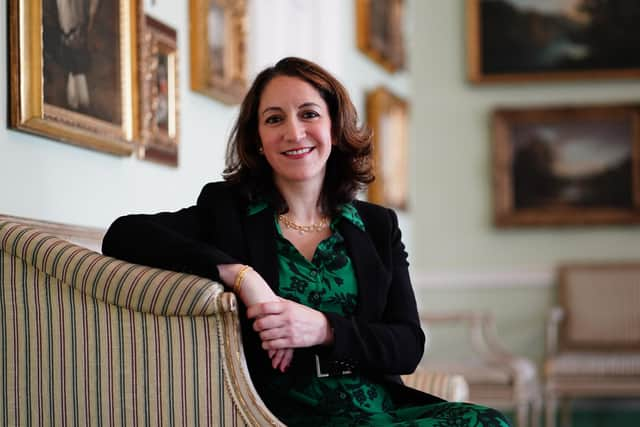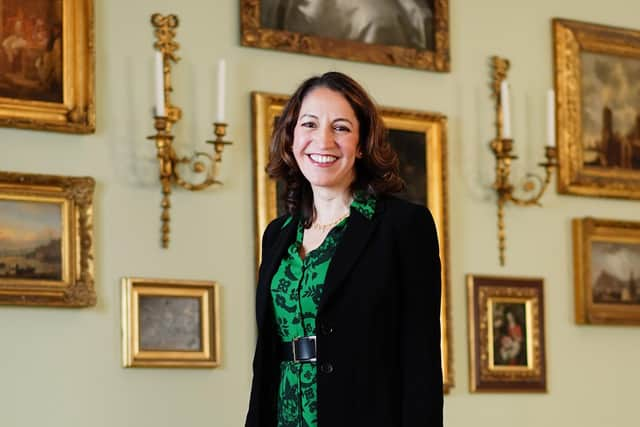The Big Interview: National Trust for Scotland COO Katerina Brown
The organisation – which this year celebrates its 90th anniversary – also says it is the largest membership organisation north of the Border.
The near-100 places in its care include Culzean Castle, the Robert Burns Birthplace Museum, Glencoe National Nature Reserve, St Kilda, Culloden, Bannockburn and Ben Lomond. Its chief executive Philip Long said in June that the Trust had been “taken for granted”.
Advertisement
Hide AdAdvertisement
Hide AdMs Brown joined the Trust as its finance boss in August 2020, harnessing her executive finance experience obtained in the asset-management, energy and property sectors, and joining from Edinburgh-based Grant Property.


She was promoted to her current role in July of this year, and says her ambition while at school was to run the 800-metre race at the Olympics, or be a doctor. “I didn’t pursue either, but ended up as a fit ‘business doctor’.”
You arrived at the Trust a year ago, and have said you’re looking forward to helping steer it through post-pandemic challenges and to build an even stronger financial basis. Can you explain more about what you aim to achieve as COO – and how you will do this as the organisation faces a deficit in its current financial year?
My overall approach has been to get back to basics; reminding ourselves of our core charitable purpose – to protect and preserve the assets of Scotland, and to promote access and enjoyment of our natural beauty and places of historic interest.
The Trust has endured a lot of change in recent years and post pandemic, I want to take it to a period of strength, stability, and resilience.


To do this involves taking a longer-term look at planning, focusing on greater efficiency in the use of our systems, in which we have invested, and better co-ordination of all activities, aligned to our core purpose.
Can you characterise how the organisation has helped prop up its finances in the pandemic, for example support from your members and the Scottish and UK governments as well as the People’s Postcode Lottery (PPL) and your Scottish Heritage Lottery, which launched in March 2020 However, the Trust was criticised before your arrival regarding the way it was handling the issue of redundancies – can you give your thoughts on this?
In March 2020, a hugely unpredictable and unprecedented time, the Trust was faced with the almost total collapse of its main income streams. Lockdown, to protect public health, meant the closure of all our properties, the loss of visitor and commercial income, and anticipated exodus of people unable to use their memberships. Despite this, there remained the need to meet the costs (which never go away) of maintaining the historic and natural places in our care.
Advertisement
Hide AdAdvertisement
Hide AdAll expenditure was cut as far as possible, and a period of fund-raising was accelerated. The Trust did move quickly to a programme of consultancy on redundancies, as many other cultural and heritage bodies have subsequently had to do.
The redundancy programme was regrettable, but unavoidable, and we are pained by the effect it has had on individuals’ lives and on our organisation. This difficult and most challenging sacrifice has contributed to the continuation of the Trust and our future security, and because of that we can be far more optimistic about what lies ahead.
The emergency appeal we launched to Save our Scotland raised an overwhelming response of £3.5 million and for that we are extremely grateful to everyone who donated. We also received a vital £3.8m grant from the Scottish Government along with help from Scottish Enterprise to produce a business recovery plan. Finally, we accessed the UK Government’s furlough scheme, which helped protect jobs until we were able to re-open properties.
Through this help and by careful management, our Statement of Financial Activities accounts for 2020/21 report a surplus of £4.4m, which as a statement on its own distorts the true financial position. We essentially have a buffer of cash caused by delayed spending and one-off fundraising activities.
When taking into account the wider financial situation, it also includes a paper increase in the value of our investment portfolio of almost £10m. A combination of the actions taken, better-than-expected stock market performance with our investments, and the extraordinary loyalty of our members, most of whom stayed with us, has helped strengthened the balance sheet.
Our properties have re-opened, staff have returned, and we are now tackling the considerable backlog of projects and maintenance deferred from last year. The forecast for this financial year is a deficit of £17m, which includes the cost of completing many capital projects including Newhailes, House of Dun, and Gladstone’s Land.
Thanks to the support received from all our donors, and organisations such as the PPL and The National Lottery Heritage Fund, the Trust’s prospects for recovery are far clearer.
NTS Enterprises has made a net loss of £950,000 following a collapse in commercial income of about 80 per cent from the previous year. With lockdown restrictions eased, what is your outlook for the current financial year for this division?
Advertisement
Hide AdAdvertisement
Hide AdThis was the first loss made by NTSE in its history, which underlines how extraordinary the situation of the past 17 months has been. The complete closure of all our places, including our shops and cafes, cancellation of events, weddings, and holidays has unsurprisingly driven this loss.
We are planning a recovery in this financial year, which is improved on 2020, but not back to pre-Covid levels. In fact, visitor numbers are down by more than 40 per cent against our forecasts, and down 50 per cent for paying visitors. It is encouraging, however, to see a boom in the staycation effect and the occupancy on our holiday properties is high throughout the season.
Could you summarise your career before joining the Trust, and explain how your experience can help it prosper? What is your biggest challenge?
My entire career has largely been spent managing assets to ensure growth and sustainability across a range of sectors. Two decades working in financial services in the City of London and Canary Wharf involved long working hours in big organisations, but it helped me hone some very strong financial and strategic leadership skills, learn efficient processes, and an ability to stay calm under pressure.
My love of Scotland was the reason I relocated from London and I feel extremely privileged to be able to apply these skills to the Trust.
No doubt my biggest challenge, in any year, is ensuring we have enough money to maintain and care for our diverse properties, whilst also investing in capital projects to develop them further and improve our members’ and visitors’ experiences. This is even more acute now as we are in a period of recovery from the pandemic and our numbers this year tell us we are far from over it.
How have you found making your debut in the heritage/culture/tourism field and what is your view on the hurdles these sectors face in a post-pandemic world?
There have been some familiar challenges – managing an organisation with limited resources is a common theme in most roles, as is working with different stakeholders and regulatory bodies. However, what is new is the sheer diversity of the Trust’s activities across Scotland.
Advertisement
Hide AdAdvertisement
Hide AdI have swapped my city suit and heels for waterproofs and walking boots to explore our fascinating places from the Victorian Bridge over the Corrieshalloch Gorge, Mar Lodge nature reserve in the Cairngorms, to the trees and plants in Arduaine Gardens on the stunning Argyll coast.
What has been the most pivotal moment in your career so far?
So many come to mind. From choosing to leave Enron at its peak, one month before its collapse; or as a woman leading the finances to open the first ever custody bank in Riyadh, Saudi Arabia; or valuing the Bank of Ireland custody business for takeover in my first 100 days. At the time, they were all pivotal in my career.
The biggest change would have to be the move to Scotland in 2014. It’s refreshing to have a better work-life balance (most of the time!).
The Trust has outlined its ten-year strategy, which will become effective in March next year. What does this aim to achieve?
The strategy will take us nicely up to our centenary in 2031 and is still very much in development as we collaborate and engage with volunteers, staff, our members, and other stakeholders to scope the key themes for launching in early 2022.
I would like the focus to be on what the Trust, as a charity, can give back to Scotland as a true leader in the conservation sector. We can foresee a more active stance on conservation, especially in relation to nature and in playing our part in dealing with climate change.
We will naturally be emphasising all the public benefits we can bring, such as to health and wellbeing, learning and education, skills-development, and employment. We have been extremely fortunate that people have demonstrated their love of this beautiful country and its history – and if we can count on the continued loyalty and support of the people, we’ll be doing our very best to support them in the ways that only we can.
A message from the Editor:
Thank you for reading this article. We're more reliant on your support than ever as the shift in consumer habits brought about by coronavirus impacts our advertisers.
If you haven't already, please consider supporting our trusted, fact-checked journalism by taking out a digital subscription.
Comments
Want to join the conversation? Please or to comment on this article.
